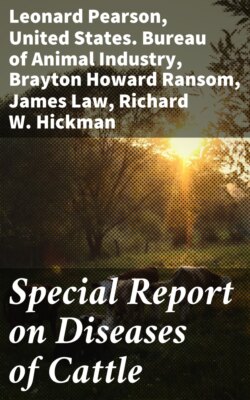Читать книгу Special Report on Diseases of Cattle - Lowe - Страница 23
На сайте Литреса книга снята с продажи.
PAROTITIS.
ОглавлениеInflammation of the parotid gland may arise from the inflammation extending to it when an ox is affected with pharyngitis or laryngitis, or the inflammation may commence in the salivary ducts and may depend on some influence the nature of which is unknown. Parotitis sometimes arises from a blow or contusion severe enough to set up inflammation in the structure of the gland. Tuberculosis and actinomycosis may infrequently be characterized by the lodgment of their parasitic causes in the parotid glands, in which case parotitis may be a symptom of either of these diseases.
Symptoms.—There is an elongated, painful swelling, beginning at the base of the ear and passing downward along the posterior margin of the lower jaw. The swelling is sometimes limited to one side, and when both are swollen it is generally larger on one side than on the other. The secretion of saliva is increased, the appetite is poor, the neck is stiff, so that it is painful to raise the head, and feed is swallowed with difficulty. In many cases the swelling of the glands, when submitted to proper treatment, disappears in a comparatively short time. In other cases, however, they remain enlarged, even after the animal recovers its appetite. In tuberculosis, lymphatic glands beneath the parotid glands are sometimes enlarged, thus causing the appearance of enlarged parotid glands.
Treatment.—A warm bran poltice, made by mixing bran with a hot 2 per cent compound cresol solution in water, should be applied on the swollen gland and kept in place by means of a bandage. Whenever the poultice has cooled it should be replaced by a new one. This treatment should be continued until the pain is less and the swelling is reduced or until there is evidence of pus formation, which may be ascertained by examining the surface of the gland with the fingers; and when, on pressing any part of the surface, it is found to fluctuate or "give," then we may conclude that there is a collection of pus at that place. It is well not to open the abscess until the fluctuation is well marked, as at this stage the pus or matter is near the surface and there is less trouble in healing the wound than if the pus is deep seated. The abscess should be opened with a clean, sharp knife. The poulticing should then be continued for two or three days, but the form of the poultice should be changed, by replacing the bran with absorbent cotton and pouring the compound cresol solution on the cotton. At all times the wound should be kept clean and the cavity injected once or twice daily with a solution of 1 dram of carbolic acid in 8 ounces of water. Under this treatment the pus may cease and the wound heal without complications. Saliva may issue from the orifice and result in the formation of a salivary fistula. This requires operative treatment by a qualified veterinarian. When poulticing fails to reduce the swelling or produce softening, the inflamed area may be rubbed once daily with camphorated oil, compound iodin ointment, or painted twice daily with Lugol's solution of iodin. The diet should be as recommended under Pharyngitis (p. 17).
